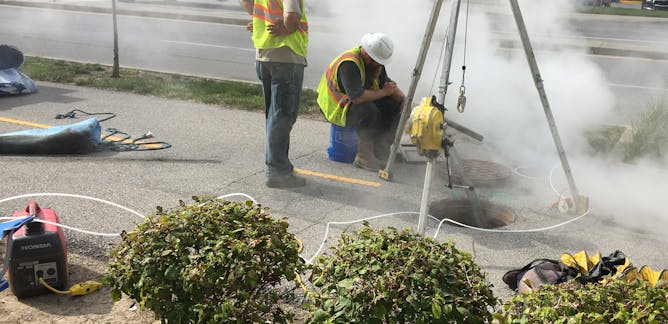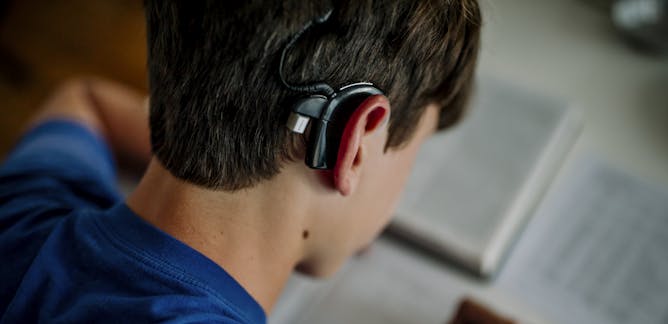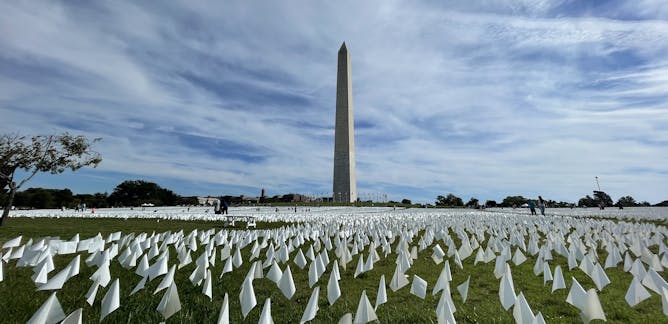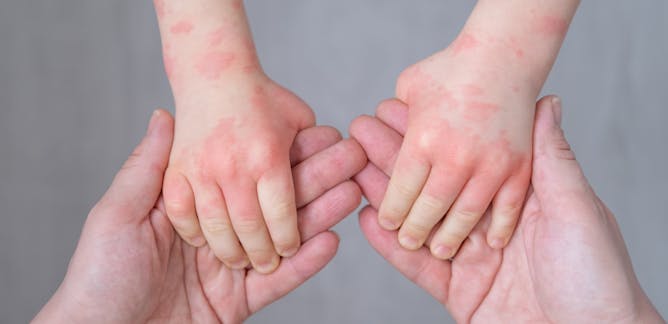|
|
|
|
Immunologist Matthew Woodruff reports today that the bivalent vaccines for COVID-19 have been disappointing in that they have not reduced transmission of the omicron variant much better than previous vaccines. His explanation as to why updated vaccines can potentially inhibit a body’s immune response to a new strain of a pathogen is particularly timely given the FDA’s proposal to recommend a yearly vaccine for COVID-19, a change that could actually help
researchers better understand this problem. “A once-yearly approach to COVID-19 vaccination opens the door for more straightforward studies on how [immune system] memory to each vaccine influences
the next,” he writes.
You may have seen headlines recently about a honeybee vaccine, which might conjure up images of sticking a tiny needle into an insect. University of California, Davis, agricultural researcher Jennie Durant, who specializes in honeybee health, explains how the trial vaccine actually works against the bacterial disease American foulbrood and what’s at stake for these very important pollinators. “Honeybees face many urgent threats, including Varroa mites, climate
change and poor nutrition, which makes this vaccine an exciting new development,” she writes.
Fellow editors in our newsroom know all too well how preoccupied I’ve been in recent years over misinformation, conspiracy theories and the general fracturing of our society over dueling versions of what is the truth. Psychologist Craig Foster writes about a class he developed to explain how people believe pseudoscience in particular. The article – like the class – gets into some of the psychological traps that we all are vulnerable to, such as relying heavily on
anecdotes or social interactions, when making sense of scientific information.
Another instructive story for me came from our Curious Kids series and is one of the most popular science stories this week. Earth and planetary sciences professor Shichun Huang from the University of Tennessee takes us on a journey through the layers of the Earth’s surface to the core and explains how radioactive elements have helped keep the inner core hot for billions of years.
In other science news this week:
If there’s a subject you’d like our team of science editors to investigate, please reply to this email.
|

|
Martin La Monica
Director of Editorial Projects and Newsletters
|
|

The FDA is proposing an annual shot against COVID-19, signaling that a new approach is needed.
wildpixel/iStock via Getty Images Plus
Matthew Woodruff, Emory University
The new bivalent boosters against COVID-19 have failed to halt omicron infections. However, new technologies are being developed that pave a way forward.
|

A new vaccine promises better protection against a virulent honeybee infection.
AP Photo/Elise Amendola
Jennie L. Durant, University of California, Davis
A vaccine for bees may evoke images of teeny hypodermic needles, but this product works in a sophisticated way that reflects the social structure of honeybee colonies.
|

The slice you see cut out of the Earth reveals its core, depicted here in bright yellow.
fhm/E+ via Getty Images
Shichun Huang, University of Tennessee
Starting at the surface, you would have to dig nearly 2,000 miles before reaching the Earth’s core. No one could survive that trip – and the 10,000-degree F heat once there would vaporize you anyway.
|
|
|

Andrew J. Whelton, Purdue University
A wave of infrastructure projects is coming as federal funds pour in. Cities need to know the risks from the cheapest, most popular repair method and how to avoid harm.
| |

Niyazi Arslan, Arizona State University
Researchers are exploring different ways to improve how cochlear implant users perceive speech and music in noisy environments.
|

Tesla Monson, Western Washington University
Using a new equation based on today’s primates, scientists can take a few molar teeth from an extinct fossil species and reconstruct exactly how fast their offspring grew during gestation.
| |

Andrew Stokes, Boston University; Dielle Lundberg, Boston University; Elizabeth Wrigley-Field, University of Minnesota; Yea-Hung Chen, University of California, San Francisco
Taking into consideration the number of excess deaths caused by COVID-19 compared with pre-pandemic years is critical to getting an accurate accounting of the pandemic’s real toll.
|

Sonal Choudhary, University of Pittsburgh Health Sciences; Jeffrey Chen, University of Pittsburgh Health Sciences
Although most skin conditions aren’t dangerous, they can be painful, irritating and frustrating to deal with.
| |

Abay Yimere, Tufts University
Many developing nations have little cold storage and lose much of their perishable food before it gets to markets. Climate-friendly refrigeration can provide huge environmental and social benefits.
|
|
|
|
|
-
Herpreet Thind, UMass Lowell
Yoga’s surge in popularity in the past decade has spurred more research into its effects. The combination of physical movement and mindfulness provides a wide range of health benefits.
-
Dan Royles, Florida International University
The US PEPFAR initiative has brought HIV medication to millions of people globally. Behind this progress are the activists that pressured politicians and companies to put patients over patents.
-
Joshua R. Smith, University of Washington; Zerina Kapetanovic, Stanford University
A wireless transmitter uses almost no power and at first glance appears to violate the laws of physics. It’s actually a clever use of physics that could one day transmit data from tiny remote sensors.
-
Craig A. Foster, State University of New York College at Cortland
A university course teaches students why people believe false and evidence-starved claims, to show them how to determine what’s accurate and real and what’s neither.
|
|
|
| | |
| | |
| |
| |
| |
|
|
|